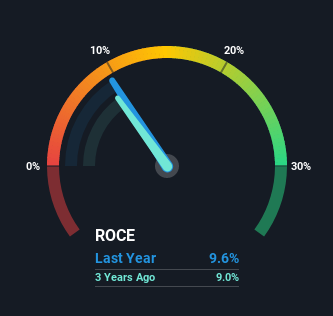- Malaysia
- /
- Industrials
- /
- KLSE:HAPSENG
Returns At Hap Seng Consolidated Berhad (KLSE:HAPSENG) Appear To Be Weighed Down
What are the early trends we should look for to identify a stock that could multiply in value over the long term? In a perfect world, we'd like to see a company investing more capital into its business and ideally the returns earned from that capital are also increasing. Put simply, these types of businesses are compounding machines, meaning they are continually reinvesting their earnings at ever-higher rates of return. Having said that, from a first glance at Hap Seng Consolidated Berhad (KLSE:HAPSENG) we aren't jumping out of our chairs at how returns are trending, but let's have a deeper look.
Understanding Return On Capital Employed (ROCE)
For those who don't know, ROCE is a measure of a company's yearly pre-tax profit (its return), relative to the capital employed in the business. The formula for this calculation on Hap Seng Consolidated Berhad is:
Return on Capital Employed = Earnings Before Interest and Tax (EBIT) ÷ (Total Assets - Current Liabilities)
0.096 = RM1.2b ÷ (RM17b - RM4.2b) (Based on the trailing twelve months to June 2021).
Thus, Hap Seng Consolidated Berhad has an ROCE of 9.6%. On its own, that's a low figure but it's around the 8.6% average generated by the Industrials industry.
View our latest analysis for Hap Seng Consolidated Berhad

While the past is not representative of the future, it can be helpful to know how a company has performed historically, which is why we have this chart above. If you want to delve into the historical earnings, revenue and cash flow of Hap Seng Consolidated Berhad, check out these free graphs here.
What The Trend Of ROCE Can Tell Us
The returns on capital haven't changed much for Hap Seng Consolidated Berhad in recent years. The company has consistently earned 9.6% for the last five years, and the capital employed within the business has risen 54% in that time. Given the company has increased the amount of capital employed, it appears the investments that have been made simply don't provide a high return on capital.
In Conclusion...
In conclusion, Hap Seng Consolidated Berhad has been investing more capital into the business, but returns on that capital haven't increased. And with the stock having returned a mere 22% in the last five years to shareholders, you could argue that they're aware of these lackluster trends. So if you're looking for a multi-bagger, the underlying trends indicate you may have better chances elsewhere.
On a final note, we found 3 warning signs for Hap Seng Consolidated Berhad (1 is potentially serious) you should be aware of.
If you want to search for solid companies with great earnings, check out this free list of companies with good balance sheets and impressive returns on equity.
Valuation is complex, but we're here to simplify it.
Discover if Hap Seng Consolidated Berhad might be undervalued or overvalued with our detailed analysis, featuring fair value estimates, potential risks, dividends, insider trades, and its financial condition.
Access Free AnalysisThis article by Simply Wall St is general in nature. We provide commentary based on historical data and analyst forecasts only using an unbiased methodology and our articles are not intended to be financial advice. It does not constitute a recommendation to buy or sell any stock, and does not take account of your objectives, or your financial situation. We aim to bring you long-term focused analysis driven by fundamental data. Note that our analysis may not factor in the latest price-sensitive company announcements or qualitative material. Simply Wall St has no position in any stocks mentioned.
Have feedback on this article? Concerned about the content? Get in touch with us directly. Alternatively, email editorial-team (at) simplywallst.com.
About KLSE:HAPSENG
Hap Seng Consolidated Berhad
An investment holding company, engages in the plantation, property investment and development, credit financing, automotive, trading, and building materials businesses in Malaysia and internationally.
Excellent balance sheet with proven track record.
Similar Companies
Market Insights
Community Narratives



